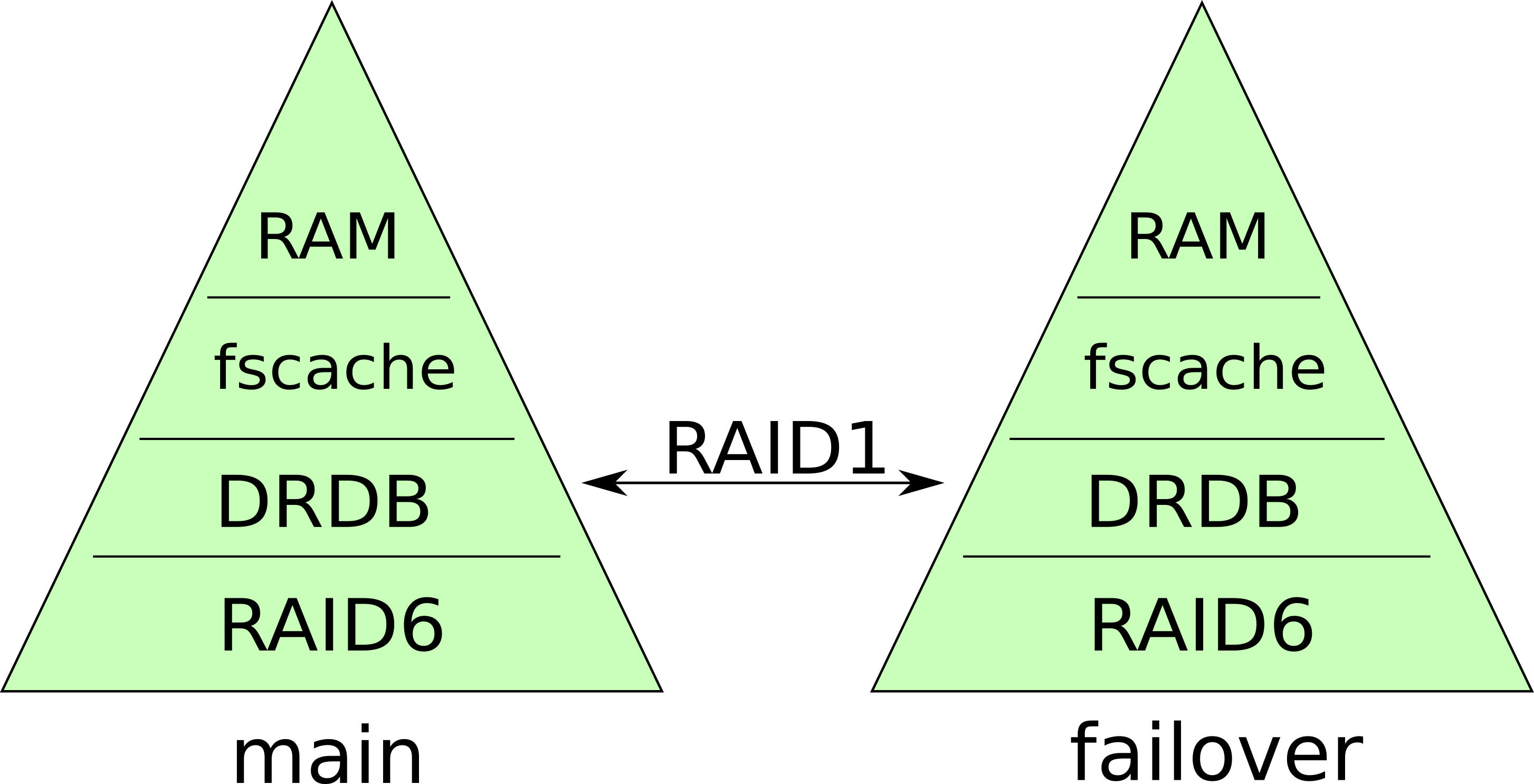ubuntu cachefs experiments
15 jun 2011
motivation
the main purpose is a ‘high availability’ file storage with with two servers: main and failover. the main server has two raid systems:
- one with fast disks and moderate disk sizes and
- another raid with slow but very big disks
the idea is to find a way to use the fast raid for** file-caching similar to ZFS or BTRFS’.**
the goal of this experimental setup is to experiment with fscache [1]. so far it seems that fscache is either bound to NFS, AFS or ISOFS (or a similar network fs technology).
experiment using:
- virtualbox 3.x on gentoo linux
- ubuntu 10.10 (guest)
- currently only main is in the experimental setup and DRBD is not used yet
- not shown in the diagram is the PV/VG/LV stuff (LVM)
there are two interesting documentations:
- [3] how to use fscache
- [4] how fscache is implemented (and how to debug it)
setup using nfs
this is a small setup to test if the mount and fscache are working on the target platform. in this case it was working great with ubuntu 10.10 desktop. setup steps:
using [2] we install the needed tools on ubuntu linux:
apt-get install nfs-kernel-server nfs-common
cat /etc/exports
/media/share 127.0.0.1(async,no_subtree_check,rw,insecure,all_squash)
nfs-kernel-server neustarten:
/etc/init.d/nfs-kernel-server restart
change the permissions on /media/share
chmod 0777 /media/share
only to test if the nfs export works we do:
mount -t nfs 127.0.0.1:/media/share /mnt/mounted-Share
after a successful test we unmount it:
umount /mnt/mounted-Share
create the cacheDir disk:
dd if=/dev/zero bs=1M count=512 of=cacheLoopDevice.dd mkfs.ext4 /mnt/cacheLoopDevice.dd
according to [3]:
tune2fs -o user_xattr /mnt/cacheLoopDevice.dd mount -o loop,user_xattr /mnt/cacheLoopDevice.dd /mnt/cacheDir
enable the cachefilesd daemon:
vi /etc/default/cachefilesd # remove the # before RUN=yes change the dir=… in /etc/cachefilesd.conf: dir /mnt/cacheDir /etc/init.d/cachefilesd restart
finally let’s mount it again but this time using ‘fscache’:
mount 127.0.0.1:/media/share /mnt/cached-Share/ -o fsc
let’s do a functionality tests:
touch /mnt/cached-Share/a ls -la /media/share
setup using nfs - no networking filesystem
as shown in the two following examples, it does not work with ext2 or ext4. it seems as if fscache forces the use of NFS/AFS/ISOFS.
ext2
mkfs.ext2 /dev/sdb1
mount /dev/sdb1 /mnt/cached-Share/
umount /mnt/cached-Share/
mount /dev/sdb1 /mnt/cached-Share/ -o fscthe error message (response to the shell command):
mount: wrong fs type, bad option, bad superblock on /dev/sdb1,
missing codepage or helper program, or other error
In some cases useful info is found in syslog - try
dmesg | tail or soext4
mkfs.ext4 /dev/sdb1
mount /dev/sdb1 /mnt/cached-Share/
umount /mnt/cached-Share/
mount /dev/sdb1 /mnt/cached-Share/ -o fscthe error message (response to the shell command):
mount: wrong fs type, bad option, bad superblock on /dev/sdb1,
missing codepage or helper program, or other error
In some cases useful info is found in syslog - try
dmesg | tail or sothe error message in (/var/log/messages):
[ 846.008443] EXT4-fs (sdb1): Unrecognized mount option "fsc" or missing valuesome performance experiments
to answer the question if all this setup is worth the effort, lets’ make some experiments:
- time cp /usr/src/linux /mnt/cached-Share/
- grep “__” /usr/src/linux -R
- time rm -Rf /mnt/cached-Share/usr
please note: i’ve changed the described setup a little bit: the virtual machine guest was given a virtual disk which was stored on a SSD driver.
performance tests inside a virtualbox guests seem to be worthless. i have to repeat similar tests on the target machine. but using a local NFS just to get ‘fscache’ working seems to be a bad design IMHO. we’ll see if it is worth it.
conclusion
seems hot-data can be used with the NFS workaround but not without it. in contrast: zfs/btrfs have direct support for adding ‘hot’ data cache:
btrfs: ‘hot data relocation’ functionality [5]
zfs: this is referred to as ‘Separate Cache Devices’ [6] or ‘ssd caching’ [7]
it would be nice to have a similar feature to fscache but for any filesystem (not limited to NFS/AFS/ISOFS) with the ability to be added dynamically (maybe using remount, so one does not have to unmount/mount the filesystem).
Edit: bcache [8] is what i actually wanted.
links
- [1] http://en.wikipedia.org/wiki/CacheFS
- [2] http://www.ubuntu-forum.de/artikel/32272/nfs-server-unter-ubuntu-einrichten.htm
- [3] /usr/share/doc/cachefilesd/howto.txt.gz (coming with deb-package: cachefilesd)
- [4] /usr/src/linux/Documentation/filesystems/caching/fscache.txt (found on my Gentoo system in 2.6.36-gentoo-r5)
- [5] http://lwn.net/Articles/397643/
- [6] http://www.solarisinternals.com/wiki/index.php/ZFS_Best_Practices_Guide#Separate_Cache_Devices
- [7] http://blogs.oracle.com/brendan/entry/test
- [8] http://bcache.evilpiepirate.org/
